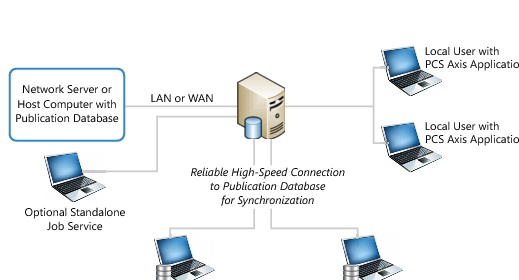About Synchronization
Synchronization uses a Microsoft SQL Server publisher/subscriber database model. The publisher database is the primary database on a network server or host computer (central database server). Each subscription database is a copy of the publication database. Remote users who do not have access to the publication database can update data in a subscription database on their local computer. Frequent synchronization between the publication and subscription databases ensures all PCS Axis users are working with the same data (
Figure 17-1).
Synchronization supports one publisher with multiple subscribers running in a client-server network. Synchronizing data between the publisher and subscribers is achieved using merge/pull replication. Merge replication is used with the publisher database. Pull replication is used with subscriber databases. After the initial snapshot of the publisher database is replicated, subsequent synchronizations only replicate data that has changed since the last synchronization.
Important: To avoid data conflicts, it is important to synchronize data between the publisher and each subscriber at frequent intervals. The subscriber must establish a reliable high-speed connection to the publisher to successfully synchronize data.
Figure 17-1. Typical Publisher/Subscriber Configuration
Note: Hierarchy Rights set up for a user in
User Management determines which pipeline segments the user has access. This also applies to remote users with a subscription database on their local computer. See
Setting Up User Management for more information.

